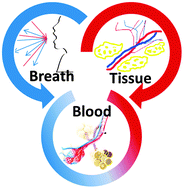Assessment, origin, and implementation of breath volatile cancer markers
Abstract
A new non-invasive and potentially inexpensive frontier in the diagnosis of cancer relies on the detection of volatile organic compounds (VOCs) in exhaled breath samples. Breath can be sampled and analyzed in real-time, leading to fascinating and cost-effective clinical diagnostic procedures. Nevertheless, breath analysis is a very young field of research and faces challenges, mainly because the biochemical mechanisms behind the cancer-related VOCs are largely unknown. In this review, we present a list of 115 validated cancer-related VOCs published in the literature during the past decade, and classify them with respect to their “fat-to-blood” and “blood-to-air” partition coefficients. These partition coefficients provide an estimation of the relative concentrations of VOCs in alveolar breath, in blood and in the fat compartments of the human body. Additionally, we try to clarify controversial issues concerning possible experimental malpractice in the field, and propose ways to translate the basic science results as well as the mechanistic understanding to tools (sensors) that could serve as point-of-care diagnostics of cancer. We end this review with a conclusion and a future perspective.


 Please wait while we load your content...
Please wait while we load your content...